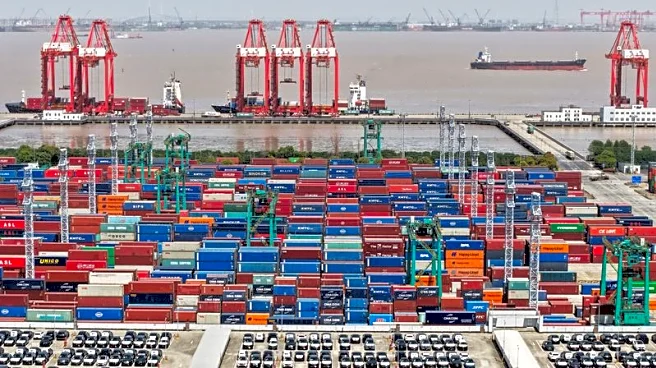What's Happening?
The Chicago Board of Trade (CBOT) soybean November contract has broken key resistance at $10.37-1/4 per bushel, indicating potential gains into a range of $10.51 to $10.55-1/4. This development is part
of an extension of the wave C, projected to reach between $10.51 and $10.59-1/2. Immediate support is noted at $10.42-1/2, with a potential decline opening the way toward $10.37-1/4. The daily chart shows the contract clearing resistance at $10.43-1/2, suggesting a rise into a range of $10.50-3/4 to $10.62-3/4. Market analysts, including Wang Tao from Reuters, have highlighted the possibility of a correction around $10.50-3/4, near the peak of wave B.
Why It's Important?
The breaking of resistance levels in the CBOT soybean market is significant for U.S. farmers and the agricultural industry, as it suggests potential price increases that could benefit producers. Higher soybean prices can lead to increased revenue for farmers, impacting their financial stability and investment capacity. This development also affects commodity traders and investors, who may see opportunities for profit in the fluctuating market. The soybean market is a critical component of the U.S. agricultural sector, influencing export dynamics and domestic supply chains.
What's Next?
Market participants will closely monitor the soybean contract's movement to assess further price changes and potential corrections. Traders and farmers may adjust their strategies based on these developments, considering the implications for future contracts and crop planning. Analysts will continue to provide technical insights, guiding stakeholders on potential market shifts. The agricultural community may also respond to these changes by evaluating planting decisions and resource allocation for the upcoming seasons.
Beyond the Headlines
The soybean market's fluctuations can have broader implications for global trade, as the U.S. is a major exporter of soybeans. Changes in prices can affect international relations and trade agreements, particularly with countries reliant on U.S. agricultural exports. Additionally, the financial health of the farming community can influence rural economies and local businesses dependent on agricultural prosperity.












